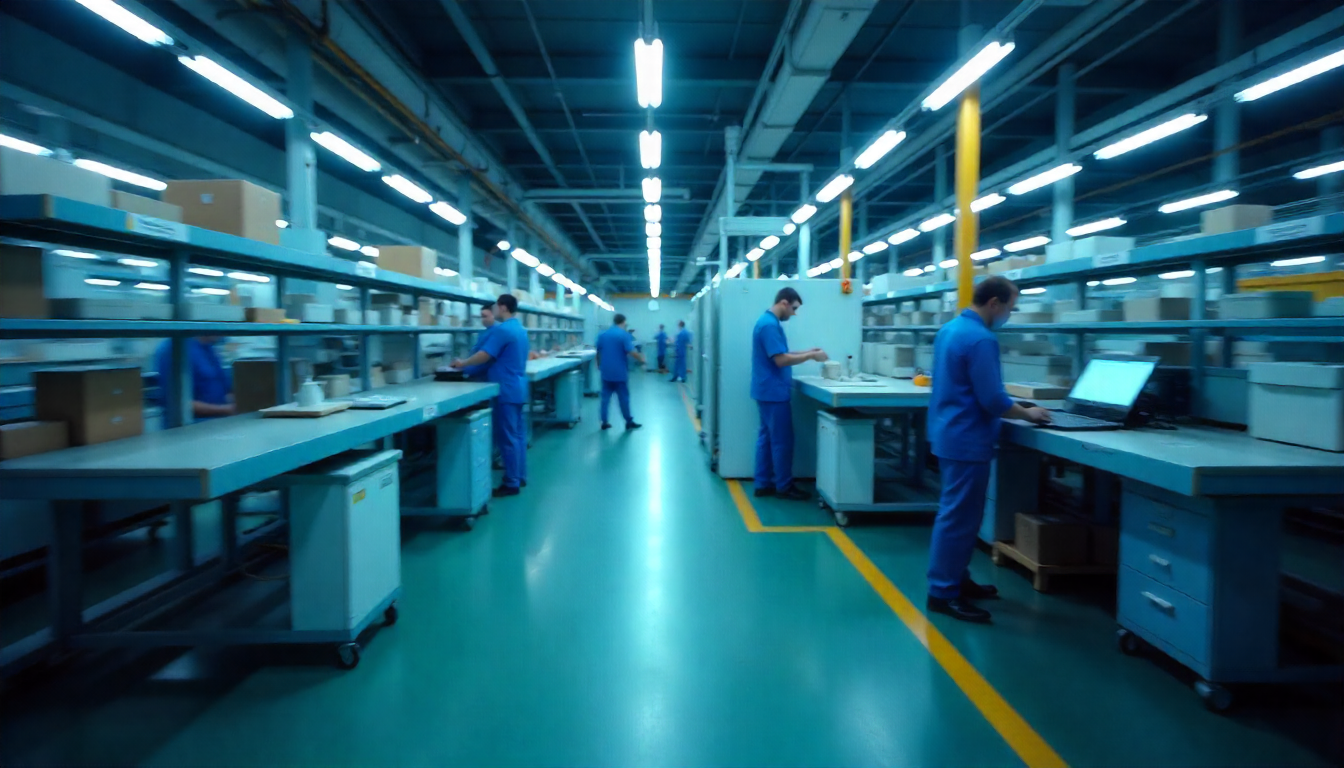How can production costs be reduced while manufacturing more safely, efficiently, and with the highest quality, yet at the lowest possible expense? This is the question that guides every professional responsible for the development of a manufacturing facility. Modern companies must simultaneously contend with rising costs of raw materials, energy, labor, and equipment maintenance. Effective cost management, therefore, requires not only ongoing monitoring of expenses but also a systematic analysis of processes to identify areas that generate losses and waste (commonly referred to as Muda).
- What sources of production costs most often burden companies?
- How can expenses be reduced without compromising quality or safety?
- In what ways do cost analysis and process optimization translate into savings and higher production profitability?
This article addresses these questions, presenting proven methods for minimizing production losses, optimizing costs, and implementing strategies for efficient production management.
The Most Common Sources of Production Costs
Costs in manufacturing facilities are complex and arise from numerous interrelated factors, which is why effective management requires a detailed analysis of this area. The most common sources of expenses include both direct and indirect costs, and identifying them forms the foundation of cost-saving strategies in manufacturing companies.
Examples of Production Costs
Raw Materials and Supplies – Their price, quality, and availability determine the unit cost of a product. Inefficient use of raw materials, mistakes in material selection, or excessive inventory can greatly increase the risk of waste. Therefore, a detailed analysis of raw material costs and management, along with implementing methods to minimize production losses in this area, is extremely important.
Labor Costs – These include wages for machine operators, contributions, bonuses, and training to improve skills. Poor organization of tasks can lead to downtime and waste, underscoring the need to analyze production costs to improve labor efficiency.
Energy and Utilities – Electricity, gas, water, and compressed air generate significant operational expenses. Increasingly, modern manufacturing facilities are turning to Energy Management Systems (EMS), which enable real-time and historical monitoring of energy and utility consumption. This allows for cost optimization, for example in electricity usage, and helps increase overall production savings.
Maintenance and Machinery Depreciation – Unplanned downtime and equipment failures can severely reduce facility efficiency and lead to high repair costs. Statistical Process Control (SPC) solutions are becoming increasingly important, as they allow critical process parameters to be monitored and potential failures predicted. This supports process stability and enables proactive decision-making before breakdowns occur, significantly reducing downtime risks and helping optimize production costs.
Logistics and Warehousing – Transport of semi-finished products, inventory management, and control of material flow have a major impact on operational expenses. Excess inventory or lack of material traceability can lead to waste. Production buffer management systems, aligned with company strategy (e.g., FIFO or LIFO), help maintain smooth material flow and reduce storage costs. This is particularly critical for products with expiration dates, where poor warehouse and internal logistics management can result in significant losses.

Process Analysis as the Foundation for Optimization
Analyzing production processes should be the first step in cost optimization, as it helps identify where losses and waste actually occur. Companies too often focus solely on obvious costs, such as raw material prices or employee wages, while hidden sources of loss may lie within the organization of the processes themselves. A process-oriented approach, therefore, involves systematically examining all stages of the workflow, from planning to internal logistics.
Example Areas for Process Analysis
- Production Planning and Scheduling – alignment of plans with execution, analysis of On-Time Delivery (OTD), and minimizing downtime caused by faulty planning.
- Raw Material and Supplies Management – inventory levels, turnover, overproduction, and losses related to storage.
- Energy and Utility Consumption – analysis of electricity, gas, water, and compressed air costs (e.g., using EMS).
- Equipment and Machinery Efficiency – Overall Equipment Effectiveness (OEE), failure rates, changeovers, and utilization of machinery.
- Process Quality and Stability – scrap rates, SPC analysis, and root cause analysis of errors.
- Internal Logistics and Material Flow – time and cost of internal transport, factory layout, and buffering strategies (FIFO, LIFO, JIT).
- Operator Work Organization – ergonomics, line balancing, and analysis of value-adding versus non-value-adding time (VA/NVA).
- Support Processes and Maintenance – planned and unplanned downtime, Total Productive Maintenance (TPM), and the impact of maintenance on production stability.
Each of these areas can be a source of hidden costs that are not visible in simple financial reports. Process analysis, therefore, provides a systematic way to answer the question: how can a company reduce costs efficiently and sustainably?

Production Cost Optimization – Tools and Methods
One of the most important methods used in practice is Value Stream Mapping. It allows for a visual representation of material and information flows, helping to identify activities that do not add value from the customer’s perspective. VSM analysis often reveals excessive waiting times, unnecessary transportation, or oversized production batches. Eliminating these elements directly reduces order lead times, lowers production costs, and improves overall process flow.
Another key area is the measurement and analysis of performance indicators. The most commonly used metric is OEE, which combines three factors: machine availability, performance, and production quality. Systematic monitoring of OEE enables precise identification of which parts of the process require optimization.
Statistical Process Control (SPC) is also playing an increasingly important role. These tools allow for tracking variability in process parameters and predicting deviations before they result in defective products. Additionally, methods such as Pareto analysis and the 5 Whys technique help identify root causes of problems rather than merely addressing their symptoms.
Manufacturing facilities are increasingly supporting process analysis with MES, which provide reliable real-time data. This data enables the identification of bottlenecks, assessment of the efficiency of individual production cells, and comparison of shift performance. As a result, companies can quickly model optimization scenarios and make decisions based on accurate, up-to-date information.
Automation and Robotics as a Means of Cost Savings
Process analysis often reveals that a significant portion of costs is generated by repetitive manual tasks, machine downtime, and inefficient material flows. In these areas, automation and robotics prove to be highly effective tools for cost reduction. Industrial robots and automated workstations not only shorten cycle times and eliminate common human errors but also increase process stability and production precision. As a result, substantial savings can be achieved in manufacturing processes.
For example, automated internal transport systems, material picking, and warehouse handling help reduce excess inventory, thereby lowering the risk of waste. Meanwhile, integration with MES systems allows real-time monitoring of performance and rapid response to production bottlenecks, directly contributing to production cost reduction.
Investments in automation also have a long-term impact. They reduce labor costs, minimize losses, and help maintain high product quality. Such initiatives, therefore, are not only a part of technological modernization but also essential tools for effective production cost management.
Effective Management of Raw Materials and Waste
Inefficient management of raw materials and waste is one of the common sources of costs in manufacturing facilities. To effectively control these expenses and reduce waste, it is advisable to use material flow monitoring and waste tracking systems, ideally as part of an MES system. This enables, among other things, production cost optimization, rapid identification of excesses and bottlenecks, and precise planning of material orders.
Common practices include:
- Inventory control – aimed at minimizing excess stock and overproduction.
- Recycling and reuse of waste – when possible, this reduces the need to purchase new raw materials and decreases waste volume.
- Optimization of material dosing and cutting processes – focusing on reducing technological losses and improving product quality.
- Analysis of material-related production costs – this identifies areas of greatest loss and supports the implementation of targeted production loss minimization strategies.
Conscious management of raw materials and waste enables real savings in production processes, increases control over expenses, and encourages better production planning. Such measures have a direct impact on enhancing facility efficiency and profitability.

Outsourcing and Lean Manufacturing
Lean manufacturing is a strategy that has been known for many years, and today it is becoming especially important in the face of rising operational costs. As we have discussed in previous articles on our blog, lean manufacturing focuses on eliminating waste, shortening production cycle times, and increasing added value at every stage of the process. For example, through systematic optimization of material flows, better scheduling, and continuous improvement of daily operations, companies can achieve tangible savings in production processes.
At the same time, an increasing number of companies are turning to outsourcing as a tool to support production cost reduction. It is clear that not all processes are profitable to maintain in-house. Delegating certain activities to specialized subcontractors allows companies to leverage their expertise, equipment, and technical knowledge while reducing fixed costs and mitigating risks associated with managing complex production processes. An example of this approach could be technical support following the implementation of an IT system.
How to Increase Profitability Through Innovation
Rising production costs are a daily challenge for everyone managing manufacturing processes. Traditional methods of expense control often fail to reveal the full picture of losses and waste. However, more effective approaches are available – MES, EMS, OEE, and SPC systems, once seen as innovative and complex, are now becoming standard in manufacturing facilities.
These tools enable informed management of resources, real-time performance monitoring, and rapid identification of areas requiring improvement. They allow for the reduction of losses and tangible cost savings, while maintaining high quality and process stability. Importantly, implementing these tools does not require a revolution; changes can be introduced gradually, safely, and consciously.
Further reading


